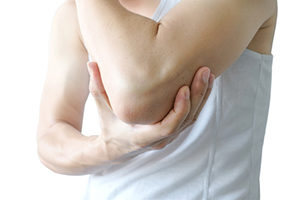Tennis Elbow: Causes, Treatment and Surgery
What is Tennis Elbow?

Lateral epicondylitis, more commonly known as tennis elbow, is a painful condition of the outer side of the elbow caused by overuse or repetitive motions. Tennis elbow may begin as a mild ache on the outside of your elbow then progress into a sharp pain that radiates down your forearm and the back of your hand. Here are some fast facts:
- Tennis elbow affects people of all ages and occupations. It is most common with adults aged 30-50.
- Tennis elbow generally affects those with jobs involving repetitive motions of the wrist and arm: carpenters, painters, mechanics, and athletes, for example.
- If tennis elbow is left untreated, it may become very difficult to pick up items and tools due to increased pain and decreased grip strength.
Meet Our Tennis Elbow Orthopedic Specialists
The tennis elbow orthopedic specialists at Seaview Orthopaedics are your trusted institute for hand, wrist and elbow orthopedics, injuries, and pain. We are committed to providing high-quality specialized hand, wrist and elbow treatments for our patients.
Schedule An Appointment with Our Tennis Elbow Specialists
What Causes Tennis Elbow?
Tennis elbow is caused by overuse of the tendons that extend or straighten the wrist and fingers. Over the course of a career involving repetitive wrist extension while the elbow is straightened, degenerative changes and microtears develop within the tendons. Eventually these degradations lead to pain at the outside of the elbow and a noticeable reduction in grip strength. Some people may find that they have difficulty carrying their purse, groceries, holding a cup, or even dropping things into their affected hand.
Treating this condition at an early stage may help maintain one’s occupation and quality of life.
What are the Symptoms of Tennis Elbow?
Symptoms from tennis elbow usually develop gradually and continue to progress with continued overuse of the forearm muscles that extend the wrist and fingers. Signs and symptoms of tennis elbow include:
- Pain and tenderness located at the outside of the elbow.
- A radiating pain traveling from the outside of the elbow into the forearm.
- Pain and weakness while gripping items —especially with the elbow extended.
What is a Tennis Elbow Examination Like?
The goal of examination is to determine whether there are signs of an injury to the tendons originating from the elbow. During your examination, a board-certified upper extremity specialist will measure your pain levels while performing tests on the muscles and tendons around your elbow. You may be asked to straighten your middle finger or bend your wrist upward while your physician pushes down on your fingers/wrist. Typically, if a patient experiences pain with this exercise, this suggests the tendons that cause lateral epicondylitis have been injured. Additional X-rays may be taken in the office at the discretion of your physician.
Schedule Your Tennis Elbow Exam Today
Conservative Tennis Elbow Treatment:
There is good news for those affected by tennis elbow: up to 95% of patients experience improvement without undergoing surgery. Seaview Orthopaedic is committed to a minimally invasive approach as we work with our patients. Initial tennis elbow treatments are non-operative and conservative. Your Seaview physician will be there every step of the way to advise you on your best treatment options.
- To relieve pain and allow the forearm muscles to rest, your physician may prescribe anti-inflammatories and the use of a brace on the elbow or wrist.
- Rehabilitation with an occupational or physical therapist is crucial for stretching out and strengthening the affected muscles in your forearm.
- Your therapist may use ultrasounds, muscle stimulation techniques, and other modalities to help the forearm tendons heal.
- A key part of treatment is to rest and avoid activities that cause pain in the elbow.
- It may take 1- 1.5 years for tendons to naturally heal and for symptoms to completely resolve.
Corticosteroid Injections for Tennis Elbow
For cases of tennis elbow where the pain is so severe that the patient is unable to perform simple tasks, a corticosteroid injection may be considered. Corticosteroid injections are typically recommended only for severe pain that hasn’t improved with the use of anti-inflammatories, bracing, or physical therapy. The corticosteroid injection usually lasts for several months. Multiple injections are not recommended due to a possibility of injuring surrounding tissues and a chance that tendon rupture may occur.
Platelet-rich-plasma (PRP) Treatment for Tennis Elbow
Recently, injections with platelet-rich-plasma or PRP have been shown to have some benefit in treating lateral epicondylitis. This is a natural treatment designed to help improve the biologic environment of the injured tissues, stimulating natural healing of the tendons. PRP injections involve taking blood from the patient’s arm and spinning the blood to obtain the patient’s natural healing platelets and growth factors. The platelet-rich-plasma is then injected into the outside of the elbow at the site of the injured tendons to stimulate healing. You can learn more about PRP injections and regenerative medicine, or be sure to ask about PRP injections during your next visit.
Tennis Elbow Surgery
We understand that some patients may not be able to avoid the activities that cause their elbow pain and prevent their tendons from healing naturally. For those who require repetitive extension of their wrists and fingers to make a living, avoiding certain movements may simply not be an option. In these cases, or if all conservative treatments do not work, surgery may be recommended. Tennis elbow surgery usually occurs at a surgical center and involves cleaning injured tendons and reattaching the healthy tendons back to the elbow. After surgery, a splint is worn for 1-2 weeks.
Because the elbow tends to get stiff very quickly after surgery, physical or occupational therapy is used to increase range of motion and restore flexibility to the elbow. It is important to note that physical therapy is an essential part of treatment as these exercises prevent elbow stiffness and loss of motion. During rehabilitation, your therapist will start gradual strengthening exercises at about 6-8 weeks after surgery. Full recovery may take up to 3-4 months after surgery.
Greater than 90% of patients do well with conservative treatment. Tennis elbow surgery is considered successful in 80 to 90% of patients, with significant reduction in pain, allowing patients to return to their prior daily activities. Patients regain about 90% of their strength in the affected arm compared to the unaffected arm. Depending on occupation, patients may expect to return to work in 2-6 weeks.
Tennis Elbow Treatments in Central New Jersey and Jersey Shore
At Seaview Orthopaedic & Medical Associates, we have provided quality orthopedic care for over 30 years! Our patients’ total experience with our practice is our number one priority. If you have been suffering from tennis elbow pain, be sure to schedule an appointment with a hand, wrist and elbow specialist at one of our six orthopedic clinics throughout NJ. To learn more feel free to contact us online.





